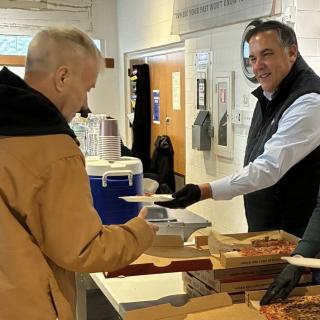Ohio State administration and the Department of Public Safety are using crime reports to manipulate how our community understands safety, and we let them get away with it.
Between July and September 2021, Ohio State blasted out 14 “Neighborhood Safety Notices” by email to the campus community, causing panic and outrage. The result? A petition was circulated pressuring the university to hire more police, and a parent-led group purchased billboards that read “COLLEGE SHOULD NOT BE A CRIME SCENE[1].”
Was there actually a dramatic crime wave last summer? As the university sent us safety tips and continued to send alerts, most of us students assumed worst. But a closer examination of the “safety notices,” along with new revelations about the crimes that aren’t being reported, points to something else. OSU administration is manipulating crime reporting to serve its own goals—goals that have a lot more to do with money than they do with safety.
We are undergraduate students in geography, and we mapped the locations of all crimes reported in “Neighborhood Safety Notices” going back to the beginning of 2017. We found that around mid-2020 while campus was still partially shut down, “safety notices” started to be sent for crimes occurring much further away from campus. And as the circle for alerts got bigger, the proportion of crimes in which Ohio State students, faculty, and staff were involved decreased significantly, from 70.5 percent in 2018-2019 to 56.1 percent in 2021.
Ultimately, this means that a “Neighborhood Safety Notice” sent before Spring 2019 was almost certain to have occurred directly adjacent to campus and to have involved an OSU student victim. In contrast, most of the crimes reported in July and August 2021 took place blocks away from campus and did not involve university community members.
In other words, by increasing the area in which it reported crimes, the university made it seem like crime had increased. But instead of making that clear to the community, university administration used a September 24 press conference[2] to talk about combatting “violent crime” with a series of questionable safety measures. Those measures included diverting $20 million away from education and research to fund police salaries and surveillance technologies. And who does that investment serve? Not students or professors, but rather the developers profiting from the ongoing gentrification north and east of Lane Avenue and High Street, accomplished by pushing out certain classes of residents and building new buildings.
What else do those investments in policing and surveillance do? They offer cover for other appalling crimes on campus that go unannounced and unaddressed. Daily crime logs[3] show a variety of armed robberies, assaults, burglaries went unreported throughout the rest of the year. Most disturbingly, a recent news report shows that 77 rapes—yes, 77—were reported to Ohio State police throughout 2021, the vast majority in on campus or student housing.[4] But not one of those rapes was sent to the campus community as a “Neighborhood Safety Notice.”
Now, the university has announced a new change; it will discontinue email notices in favor of a “Community Crime Map.[5]” Unsurprisingly however, this crime map once again reinforces the idea that students should fear off-campus crime and our community neighbors. It defaults to show just assaults, robberies, and burglaries but not sexual assaults, and it flat out does not include on-campus crimes. For President Kristina Johnson, Senior Vice President Jay Kasey, and Director of Public Safety Monica Moll, we should be scared of random robberies and assaults by young black men and houseless people. Nowhere does the “community crime” map suggest the sad truth that we are far more likely to be sexually assaulted in our dorms and houses by other students, staff, or faculty than we are to have our iPhones stolen at gunpoint.
So why didn’t “Neighborhood Safety Notices” report those 77 rapes, and why does the new map continue not to show those which have taken place already in 2022?
University administration knows that by keeping quiet about the dozens of students who are sexually assaulted on their watch instead of working to combat sexual violence in collaboration with students, they leave more unsuspecting victims to become survivors. They also know that multiple diversions of more money from financial aid and educational programs to the police have never actually reduced crime, whether robberies or rapes. But those police continue to work to push out all those people that the university doesn’t view as part of the University District “community.”
To be clear, we are not advocating for OSU to send us more crime alerts of any kind. Ultimately, “Neighborhood Safety Notices,” the “Community Crime Map,” and the reporting systems for on-campus crime are all different sides of the same coin. They are all attempts to define and control what students and community members fear, what they don’t know, and who they blame.
[1] https://www.10tv.com/article/news/local/parents-of-ohio-state-students-b...
[2] https://www.youtube.com/watch?v=OfJUEN8fwm0&t=3s
[3] https://dps.osu.edu/daily-crime-log
[4] https://www.nbc4i.com/news/local-news/ohio-state-university/77-rapes-rep...
[5] https://www.thelantern.com/2022/03/ohio-state-to-replace-off-campus-neig...



